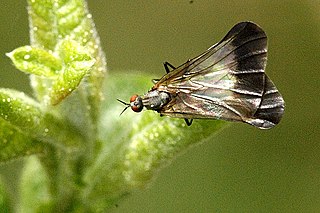
The Empidoidea are a large monophyletic superfamily of true flies, the sister taxon to the Muscomorpha (Cyclorrhapha). These two groups are sometimes united in the unranked taxon Eremoneura. There are some 10,000 known species within Empidoidea, which are represented on all continents except Antarctica. They are known to have existed since the Jurassic period.

Empididae is a family of flies with over 3,000 described species occurring worldwide in all the biogeographic realms but the majority are found in the Holarctic. They are mainly predatory flies like most of their relatives in the Empidoidea, and exhibit a wide range of forms but are generally small to medium-sized, non-metallic and rather bristly.

Hybotidae, the typical dance flies, are a family of true flies. They belong to the superfamily Empidoidea and were formerly included in the Empididae as a subfamily.

Atelestidae is a family of flies in the superfamily Empidoidea. The four genera were placed in a separate family in 1983; they were formerly either in Platypezidae or considered incertae sedis. While they are doubtless the most basal of the living Empidoidea, the monophyly of the family is not fully proven. The genus Nemedina seems to represent a most ancient lineage among the entire superfamily, while Meghyperus is probably not monophyletic in its present delimitation, and it is liable to be split up eventually, with some species being placed elsewhere. In 2010, the genus Alavesia, previously only known from Cretaceous fossils, was found alive in Namibia, subsequent species were also described from Brazil.

Trichopezinae are a subfamily of empidoid flies. They are mainly predatory flies like most of their relatives, and generally small to medium-sized, long-legged and large-eyed.

Dolichocephala is a genus of dagger flies in the family Empididae. There are at least 50 described species in Dolichocephala.

Rhamphomyia is a genus of dance flies, in the fly family Empididae. It contains more than 600 species in 8 subgenera.

Tachydromiinae is a subfamily of hybotid flies widespread in the world.

Ocydromiinae is a subfamily of hybotid flies.

Brachystomatinae is a subfamily of flies belonging to the family Empididae.

Clinocerinae is a subfamily of flies belonging to the family Empididae.
Chersodromia is a genus of flies in the family Hybotidae.
Empis snoddyi is a species of dance flies in the family Empididae. It is present in the United States, specifically mountainous areas from southern Virginia to northern Georgia. These flies are known for their distinctive mating ritual in which the males offer the females a large empty sack filled with hundreds of silk bubbles.
Anthalia is a genus of flies in the family Hybotidae.

Ragadidae is a family of true flies in the superfamily Empidoidea. It was formerly considered a lower taxon, but was published as a new subfamily within Empididae in 2016. Since then, it has been classified as the sister group to Empididae, and has been elevated to family level based on the genetic differences which separate it from Empididae.

Heleodromia is a genus of flies in the family Empididae.

Ceratomerus is a genus of flies in the family Empididae.
Zealandicesa is a genus of flies in the family Empididae.
Wiedemannia is a genus of flies in the family Empididae.

Isodrapetis is a genus of flies in the family Hybotidae.













